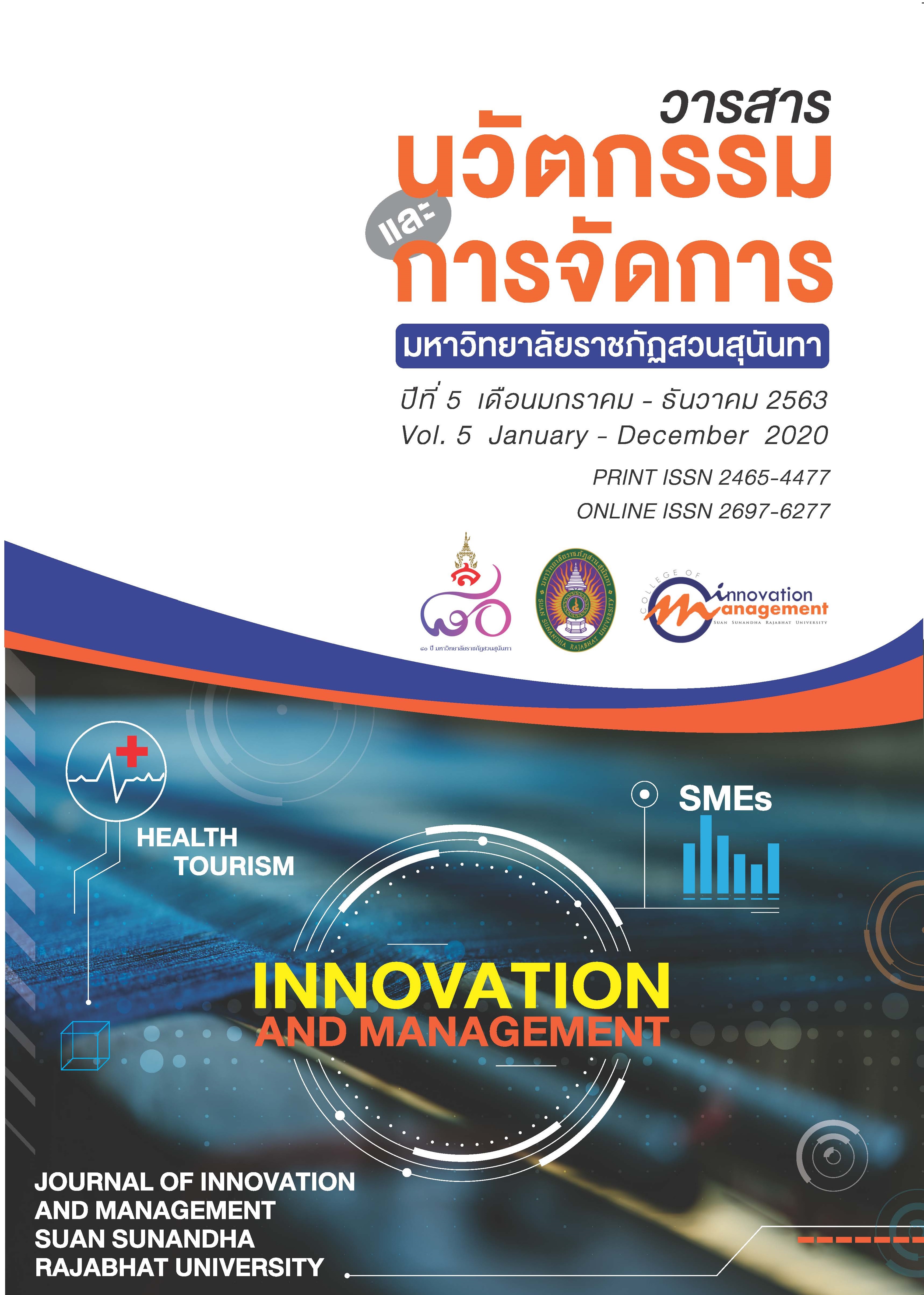ปัจจัยที่ส่งผลต่อการยอมรับต้นแบบนวัตกรรมการบริหารจัดการ งานก่อสร้างอาคารพักอาศัย
คำสำคัญ:
การยอมรับเทคโนโลยี, ต้นแบบนวัตกรรม, การบริหารจัดการ, งานก่อสร้างอาคารพักอาศัยบทคัดย่อ
การศึกษาครั้งนี้มีวัตถุประสงค์ 2 ข้อ คือ (1) เพื่อศึกษาลักษณะประชากรศาสตร์ ที่ส่งผลต่อการยอมรับต้นแบบนวัตกรรมการบริหารจัดการงานก่อสร้างอาคารพักอาศัย และ (2) เพื่อศึกษาปัจจัยด้านการยอมรับเทคโนโลยีที่ส่งผลต่อการยอมรับต้นแบบนวัตกรรมการบริหารจัดการงานก่อสร้างอาคารพักอาศัย ระเบียบวิธีวิจัยเป็นงานวิจัยเชิงปริมาณ กลุ่มตัวอย่างคือ ผู้รับเหมาก่อสร้าง ในกรุงเทพมหานคร จำนวน 317 คน ใช้วิธีการสุ่มตัวอย่างแบบชั้นภูมิ เครื่องมือที่ใช้ในการวิจัย คือ แบบสอบถาม การวิเคราะห์ข้อมูลโดยใช้ สถิติเชิงพรรณนา คือ ค่าความถี่ ค่าร้อยละค่าเฉลี่ย และค่าเบี่ยงเบนมาตรฐาน และสถิติเชิงอนุมาน คือ การวิเคราะห์ความแปรปรวน และการวิเคราะห์ความถดถอยเชิงพหุ ผลการวิจัยพบว่า (1) ลักษณะประชากรศาสตร์ ที่ส่งผลต่อการยอมรับต้นแบบนวัตกรรมการบริหารจัดการงานก่อสร้างอาคารพักอาศัย ประกอบด้วย เพศ อายุ ระดับการศึกษา สถานภาพ และเขตพื้นที่รับเหมาก่อสร้าง พบว่า ผู้รับเหมาที่มีระดับการศึกษาต่างกันยอมรับต้นแบบนวัตกรรมการบริหารจัดการงานก่อสร้างอาคารพักอาศัยแตกต่างกันที่ระดับ .05 นอกนั้นไม่พบความแตกต่าง และ (2) ปัจจัยด้านการยอมรับเทคโนโลยีที่ส่งผลต่อการยอมรับต้นแบบนวัตกรรมการบริหารจัดการงานก่อสร้างอาคารพักอาศัย สามารถทำนายได้ 62.6% เมื่อทดสอบตัวแปรอิสระที่ส่งผลต่อตัวแปรตาม พบว่า พฤติกรรมที่มีแนวโน้มที่จะใช้ ทัศนคติในการใช้งาน และการรับรู้ถึงประโยชน์ ส่งผลต่อการยอมรับต้นแบบนวัตกรรมการบริหารจัดการงานก่อสร้างอาคารพักอาศัย อย่างมีนัยสำคัญทางสถิติที่.05 ดังสมการ = .255 +.482 (X4) + .314 (X3) +.127 (X2)
References
Alvin, T. (1980). The Third Wave. New York: William Marrow.
Boonying, J. (2016). Construction work management at Maptaphut industrial estate. [Online]. Retrieved June 11, 2020 from: https://so05.tci-thaijo.org (in Thai)
Business Services Division. (1983). Department of Business Development. [Online]. Retrieved May 5, 2020 from: https://dbd.go.th/index.htm
Chaweesuk, S. & Vongjaturapat, S. (2016). Theory of the acceptance of information technology adoption. [Online]. Retrieved May 23, 2020 from: http://www.it.kmitl.ac.th (in Thai)
Davis, F.D. (1993). Perceived usefulness, perceived ease of use, and user acceptance of information technologies. MIS Quarterly, 13(3), 319-340
Drucker, P.F. (1985). The Discipline of Innovation. Harvard Business Review, 68(4), 67-72.
Fishbein, M. and Ajzen, I. (1975). Belief, attitude, intention, and behavior: an introduction to theory and research. MA: Addison-wesley.
Hughes, C. (2003). What does it really take to get into the Ivy League & other selective colleges? New York: McGraw-hill.
Kitisiri, S. and Chokworakun, K. (2018). Participation of people in the administration according to the objective plan of Robmueng sub-district administrative organization, Mueng district, Chaiyaphum province. Journal of Innovation and Management Suan Sunandha Rajabhat University, 3(3), 15-31. (in Thai)
Leelaphatthanawong, P. and Pinvanichkul, T. (2019). Factors influencing the acceptance of innovation and technology: A case study of electric vehicles (not more than 7 passengers). [Online]. Retrieved June 4, 2020 from: file:C/Users/User/downloads/kmuttv42n_1%20(3).pdf (in Thai)
Muensirichai, S. (2012). Factors affecting the acceptance of ERP software from the perspective of accounting users. [Online]. Retrieved June 2, 2020 from: http://liblog.dpu.ac.th/article/upload/b141.pdf (in Thai)
Panyawai, P. and Supawan, R. (2016). The technology acceptance and country of origin related factors affecting the attitudes towards cosmetic online pre-orders of consumers in Bangkok. Journal of Innovation and Management Suan Sunandha Rajabhat University, 1, 31-39. (in Thai)
Rogers, E.M. (1995). Diffusion of Innovation. 4th ed. NY: The Free Press.
Satawatin, P. (2003). Teaching material of the course Communication for development. [Online]. Retrieved June 4, 2020 from: http://tnsuc.ac.th (in Thai)
Silpjaru, T. (2006). Research and data analysis using SPSS. 11th ed. Bangkok: Business R & D. (in Thai)
Siririn, J. (2020). New normal: Small contractors optimize the COVID situation. Retrieved May 23, 2020 from: https://www.sarika.com (in Thai)
Ubonthum, K., Phipatsakunkamon, T., and Wantanakomol, S. (2016). Demand and key factors affecting decision making to use e-fulfilment service of e-commerce entrepreneurs. Journal of Innovation and Management Suan Sunandha Rajabhat University, 1, 14-22. (in Thai)
Waroonkun, T. (2018). Factors affecting the prefabrication system adoption of construction related personnel. [Online]. Retrieved June 11, 2020 from: https://madlab.cpe.ku.ac.th/TR2/?itemID=297530 (in Thai)
Yamane, T. (1967). Statistic: An introductory analysis. 2nd ed. New York: Haper & Row.
Downloads
เผยแพร่แล้ว
How to Cite
ฉบับ
บท
License
Copyright (c) 2020 วารสารนวัตกรรมและการจัดการ

This work is licensed under a Creative Commons Attribution-NonCommercial-NoDerivatives 4.0 International License.
โปรดดูที่จริยธรรมการตีพิมพ์ https://so03.tci-thaijo.org/index.php/journalcim/Ethics





